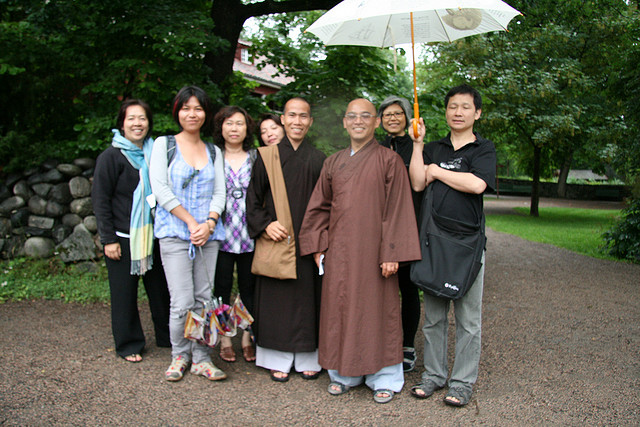
Standing alone in a relatively remote area, at a metro station somewhere far from the city center, I asked myself what I was doing? Why did I want to go to a complete stranger at this late hour, in the middle of nowhere? Well basically this area was still in Oslo, but for a first-time tourist in the city, it might as well be the Norwegian bush.
It was quiet and dark except for faint lights from surrounding flats. An image of a Norwegian wacko jumping out from these bushes crossed my mind, but I ignored and assured myself that I was in one of the safest countries in the world. There is a higher chance that I’d die from the severe weather.
A month earlier, Thor replied to my request to host me in Oslo. We exchanged SMS and emails to confirm my arrival time and the direction of his flat. Thus here I was, waiting and worrying, next to some Norwegian bushes, but I didn’t worry for long. In the end, a Norwegian did emerge from the bush zooming toward me on this bike, but it was my host.
Thor lived in a small studio, Everything in there was small: the kitchen, the living room, the bedroom, the bathroom, the balcony, but they all fitted together nicely. Most singles I knew who lived in Western European capitals tend to live in such studio, small but comfortable enough for a single and more importantly cheap. You have to give it to Europeans on how they manage to carve out a very nice living arrangement in such a tiny place.
Tourists didn’t come to Oslo and then miss out on Vigeland park where Norwegian variations of Michaelangelo’s hot boy David are on display everywhere. The park was an open-air museum of whose-body-is-it-anyway: naked statues surrounded a colossal phallus made from what else nude sculptures.
Tourists and locals of all ages pretty much followed the same routine: gasped in disbelief and giggled like teenagers seeing their first rated film. Then as if finally they understood European arts, they started to behold the statues with great enthusiasm and started moving in closer to these naked bodies for some memorable shots to show off with people back home. By now, I should have been ‘European’ enough and gotten used to the artistic values of nudity. However, this public ‘orgy’ did make my head turn and indeed my dead ancestor would come out of their graves.
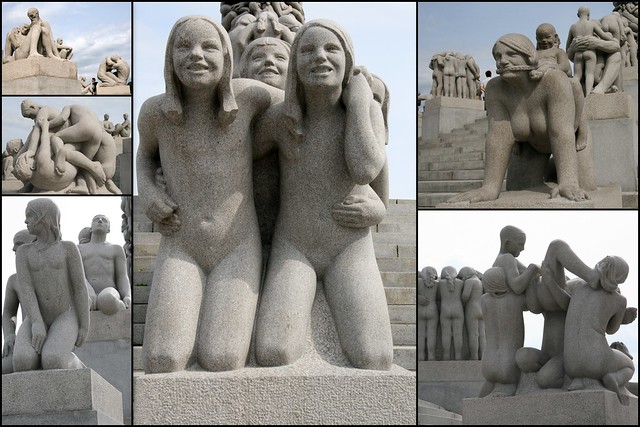
Nude sculptures at Vigeland park
Scandinavian countries, other than nature, have little to offer given the dull weather. Unless there is a local who can show you around or a friend to travel with, you’ll quickly end up bored. Thor took me to Hausmania, a sub-cultured, liberal neighborhood flanked by graffiti walls. This neighborhood was almost a replica of Copenhagen’s autonomous Christiana except that the residents here were more opened and relaxed. You could walk in and out, opened secret doors, and nobody cared.
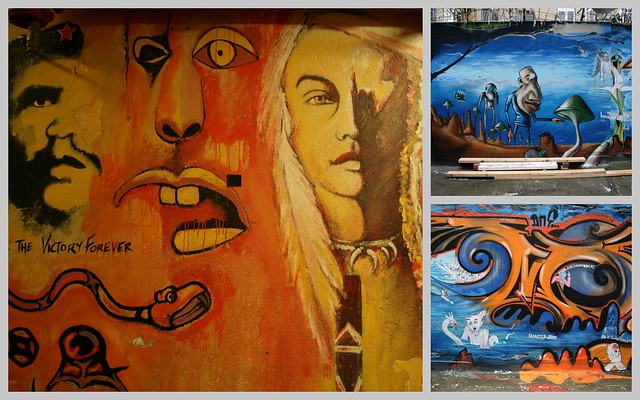
In Christiana, people put up signs forbidding people from taking photos. We didn’t arrive at the main entrance. Thus, when Thor tried to remove the chains from the locked gate, I thought we were visiting the home of one of his friend, oblivious to the overwhelming signs indicating we were about to enter a hippie community. Thor and I roamed the vacant lot, walked from one empty quarter to another, ran into very few people that sharply contrasted the lively atmosphere in Christiana. It made sense given Hausmania was just a culture center of Oslo while Christiana had its autonomy, subjected to no rule from the city government as the rest of inhabitants of Copenhagen. These sort of places were drug dens, and in Christiana, it turned into a drug haven where people are free to make drugs, sell them in front of the watching eyes of the police who stood outside. Yes, you could do it inside, but don’t get caught with it once you get out.
Leaving Hausmania, we moved on to Gronland neighborhood to tour Brugata street lined up with Vietnamese grocers, ethnic textile shops and ethnic restaurants. As we were walking toward the area, Thor casually alerted me: “If you walk through this area often, chances are you will get robbed.” “Oh! So why are we walking this way?” I raised my eyebrows to his comments. He shrugged, “to show you around.”. Then he continued to take me to the very same area where there was some chance I’d go home without my camera and wallet but trusting that statistics worked, I confidently followed him. I shouldn’t get robbed here given this was my first time, nowhere near ‘often’ yet.
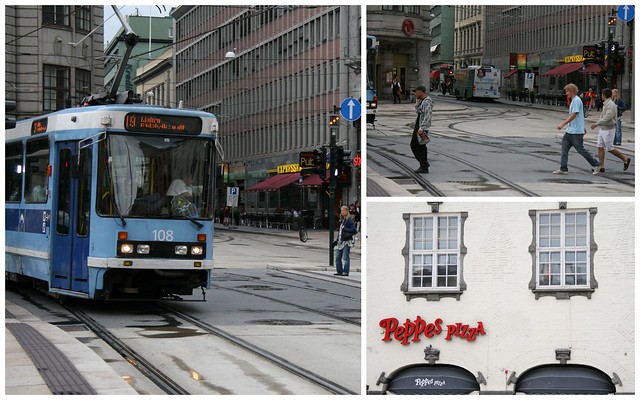
The day after, In the somber weather, we took the bus to Vippetangen quay where ferries departed to the islands in Oslofjord, southeast of Akershus Festning. Hovedøya, the closest island to mainland Oslo, was a sunbathing spot in the summer. It was impossible to believe this was the middle of the summer under chilly, rainy weather, typical weather of Norway. From the island, I could spot old cannons and ruins from a 12th-century monastery. Boats to Hovedøya left from Vippetangen once or twice per hour from late May to mid-August, less in the rest of the year. Every Dutch has a bike. Every Czech has a mobile phone. And every Norwegian Islander has a boat. Seem like every European has at least something.
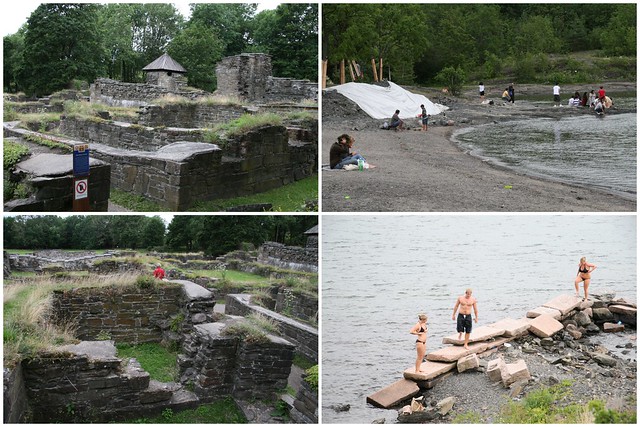
The free National Gallery became the next best hangout to cope with the increasingly depressing, cloudy and rainy weather. The gallery had a few rooms featuring French impressionism and classic Dutch still-life and landscape painting, and the rest dedicated to local Norwegian painters. My only interest was Edward Munch and his famous art piece “I know what you did last summer.” I mean “Scream” or the painting with one abstract hairless weirdo mouth wide open screaming in a middle of a bridge. Being here in Norway during the ‘best’ season of the year, I could understand the melancholy and suicidal motif in many of Munch’s paintings. Heaven forbids, he was a Norwegian.
Thor spotted an unusual setup from the gallery window with an “exhibition” sign posted outside. It was still raining, so killing time and empowering the brain culturally yet again was the only logical choice. Most tourists would have overlooked this modern art exhibition, an extension of the National Museum of Culture Design because it wasn’t advertised and highly visible despite being just across from the National Gallery. The small exhibition room was divided into irregular segments by wooden planks and cardboards, painted and covered with pop art motif. Once minute in and I felt lost in a maze; I could not tell where the other people were despite clearly hearing their voices. I spent an hour or so following dark entrance accentuated by the vividly red wall.
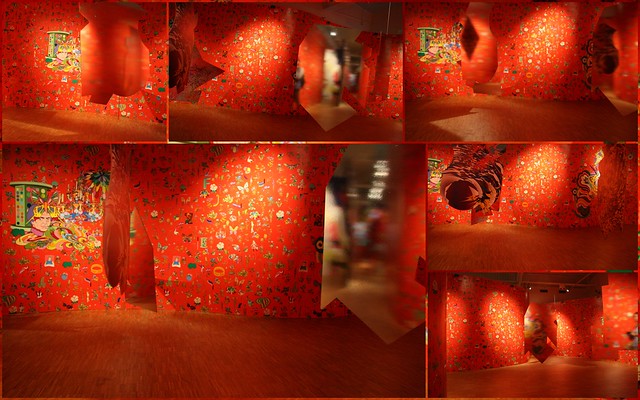
An art exhibition at the National Art gallery
If I live in Scandinavia, I will certainly be culturally depressed from having to visit many museums and indoor culture events to avoid the reality of the outside weather. I bet Norwegians are either cultured or good at indoor and winter sports. This isn’t the kind of environment which encourage people to spend around doing nothing; you will be bored to death.
By the way, did I mentioned that Norwegian suicide a lot too, not from illness, job-related stress, poverty often found in other countries, but probably from the weather.
From the museum, we hopped on bus 30 to Bidoy to visit one of Oslo’s premier attractions, the Norwegian Folk Museum, Norway’s largest open-air museum. The museum had more than 140 buildings, mostly from the 17th and 18th centuries from around the country, rebuilt and organized into regions of their origins. The look resembled an unoccupied farm with unattended shelters and elevated timbered farmhouses.
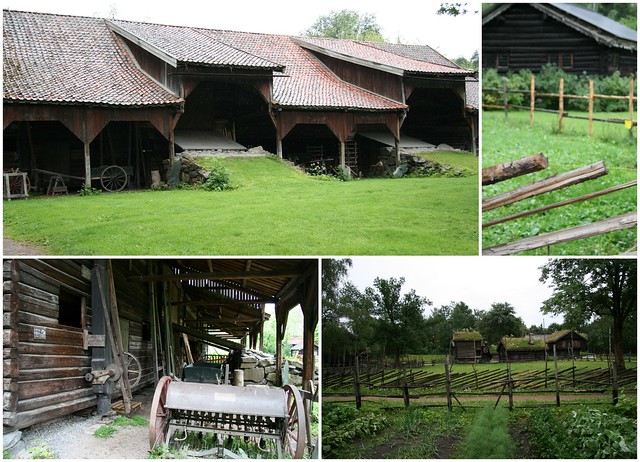
Every day during the summer and on the weekend during winter, you would find the staff dressed in traditional costumes working in confection shops, pharmacy, performing folk dances or baking bread to give tourists a feel of how life was in the past. I entered the first house to try coffee brewed by a local lady and tasted cinnamon-covered almond chocolate. She chatted with Thor and occasionally asked me a few things in perfect English. It was fantastic and bewildering to come to such place and have people communicate with you in excellent English.
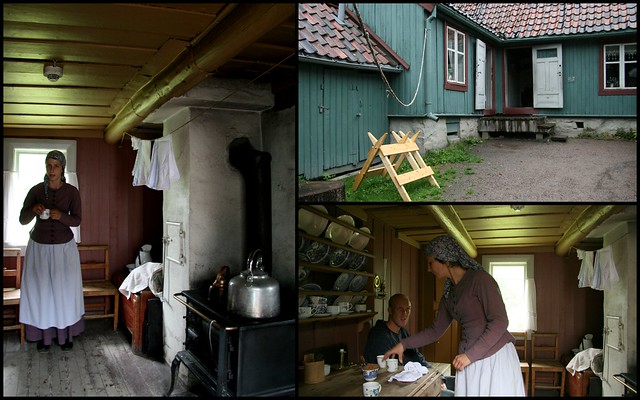
Welcome to Scandinavia where most Scandinavians speak fluent English. From the ‘coffee’ house, I walked about, hopped in and out of few other farmhouses before arriving at the bread-baking demonstration. Two ladies were taking turns preparing the dough and churning out popping-hot thin slices of bread. For only 20 kroner, I highly recommend the bread. The sweet bread and the homemade butter melt on my tongue while their aroma still lingered even a few blocks down the road.
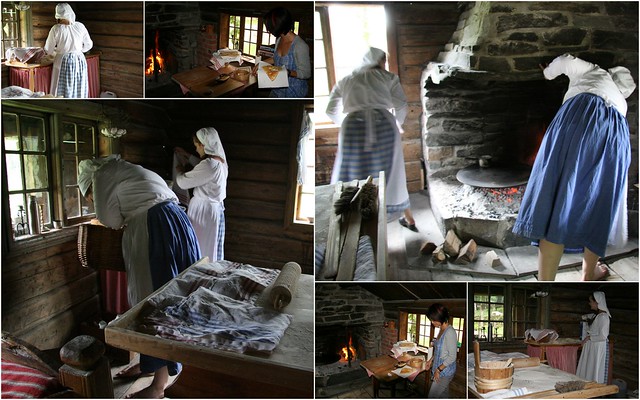
Bread making demo
Out from the bread house, I ran into a group of Vietnamese from Moss, a city right outside of Oslo, who were escorting a Vietnamese Buddhist monk they met while visiting New Deli, India. To be honest, I didn’t run into them; I sought them out after catching their conversation from afar. I walked near them for a while before finally approaching them to say hi. I was not sure about my behavior given how much out of whack I felt being around Vietnamese. We have two different channels of communication. We want different things in life. I can’t or don’t want to explain myself to them, and the less I see them, the better. Whatever it is, the Norwegian weather amended it well. We exchanged a few words and took a group photo, and I felt deliriously happy. How strange!

Meeting a group of Vietnamese who escort a Buddhist monk.
Bad weather + Strange place + Closed stranger = Root?
Parted way with the Buddhists and didn’t know where Thor was, I lost him when I was trying to attach myself to the Vietnamese. Thus I continued my way to a medieval wooden church or stave church. Churches like these, except for one in Sweden, could be found only in Norway. They were believed to be the first kind of church built in Scandinavia and later replaced during the middle ages. The church reminded me a lot of Asian design especially with the dragon head and the wood-carving. Up until this point, I had always thought that dragon is the sole symbol of Asian culture. As a matter of fact, according to legend, the first 100 Vietnamese came from 100 eggs of the Sky Fairy Mother and the Sea Dragon father. Dragons also dominate the Chinese and Japanese culture. I wondered how the dragon symbols spread to here, maybe through contacts with the Vikings who navigated the marine world?
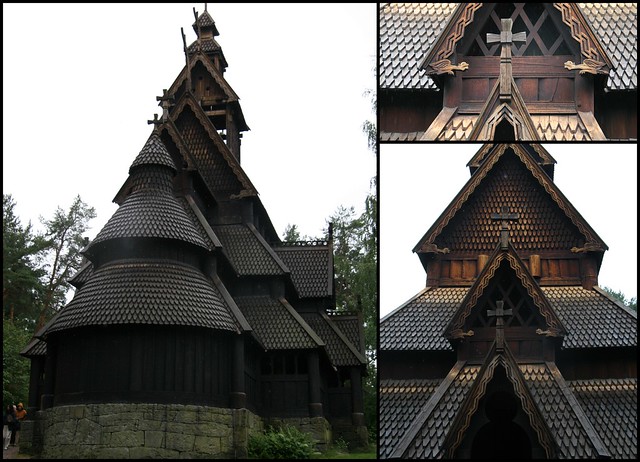
July 10th, 2009
[slickr-flickr type=”galleria” tag=”oslo” caption=”on” descriptions =”on”]